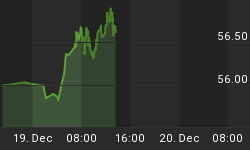In 2008, the market that was the trigger for other markets was the currency market. The bottom in the dollar led to a peak in commodities and helped spur massive deleveraging and selling of various holdings. For certain, the increasing strength of the Yen also caused great damage to the global economy and global capital markets. There were only a handful of places to hide, free of volatility and immediate risk. Either you owned government bonds, the dollar or the yen. Gold advanced in 2008, though with extreme volatility compared to other safe-havens.
We believe that 2009 will be similar to 2008 in that a particular market will affect all other markets. As we showed in the Market Outlook, Treasuries are very likely to be the key market and that also includes foreign government bonds (of the largest nations). There is a reason its simple. In a deflationary environment money moves to the safety of government bonds. Governments increase their size to help the economy fight deflation, which cripples the private sector. A recovery ensues after money exits government bonds for more productive purposes.
In today's case money will move out of government bonds to seek a real safe haven and to maintain purchasing power and the value of savings. Keep in mind that the US in 1929 and Japan in 1990 maintained surpluses. Few nations have a current account or budget surplus. Furthermore, exacerbating conditions will make it more difficult for the creditor nations to lend to the debtor nations. Essentially, the decline in the US trade deficit, commodity prices and economic activity will lead to tight global liquidity, fewer creditor nations and ultimately monetization. The crash in oil means that Russian and Arab Treasury purchases will decline drastically. The global recession will halt and/or limit Japanese and Chinese Treasury purchases. The massive decline in commodity prices will hurt the accounts of Brazil, Canada and Australia. Furthermore, why would one government lend to other governments in debt when they have their own economic problems to worry about?
In the wake of the crisis, the currencies of weaker nations were hammered. These nations don't have the borrowing power of the US or UK and their debts are often denominated in foreign currencies. Hence, printing money would cause immediate hyperinflation to their currencies. In 2009 the borrowing power of the stronger nations is going to run out. Creditor nations will endure reduced surpluses and thus a reduced capacity to lend. Also, citizens can only buy so many government bonds. This is how and when monetization will occur.
Budget deficits will bleed red and government bonds will begin to plunge, reflecting aside from poor fundamentals, the diminishing capacity of global lending. The larger nations are going to have to monetize and that is what will spark the real surge in Gold and Silver. Just take a look at these headlines from Bloomberg on January 19!
Eurozone budget deficits to soar as economy shrinks
http://www.reuters.com/article/bondsNews/idUSLJ68077620090119
Gilts Tumble on Speculation U.K. Government Borrowing Will Rise
http://www.bloomberg.com/apps/news?pid=20601085&sid=aKq0D8MmJxow&refer=europe
Spain Downgraded by S&P as Slump Swells Budget Gap (Update3)
http://www.bloomberg.com/apps/news?pid=20601087&sid=aNdVKbHeAvTw&refer=home
Keep in mind that we write with a full 2009 in view. Until government bonds and specifically US Treasuries roll over, deflation is the order of the day. Be wary however, as the "whip-around" is likely to be quick and nasty. It will be difficult to determine the imminence of, though we will do our absolute best in spotting it! Our thoughts on when this "whip-around" is likely to occur are included in our 2009 Market Outlook. For more analysis, details and projections on 2009, you can visit our website at www.trendsman.com and purchase our 58-page Market Outlook report for $45. This also includes the January 20th issue of our newsletter (17 pages). All the best to everyone in 2009!















